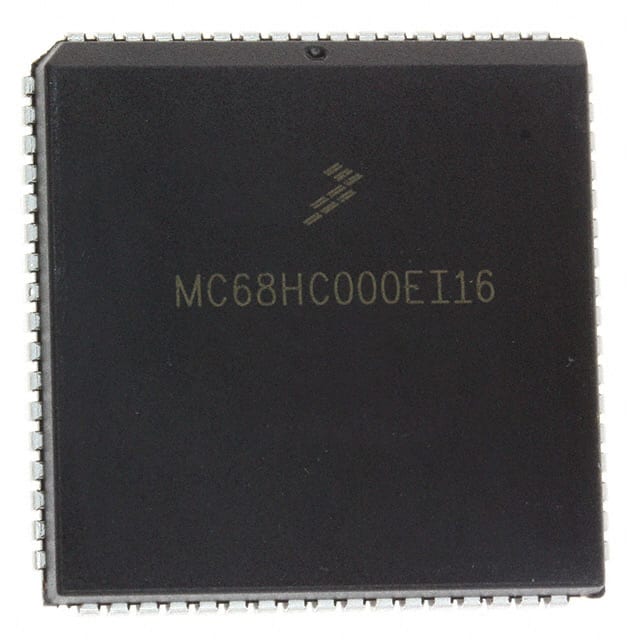Xem thông số kỹ thuật để biết chi tiết sản phẩm.

MCHC11F1VFNE3
Basic Information Overview
- Category: Integrated Circuit (IC)
- Use: Microcontroller
- Characteristics: High-performance, low-power consumption
- Package: Surface Mount Technology (SMT)
- Essence: 8-bit microcontroller with advanced features
- Packaging/Quantity: Tape and reel packaging, quantity varies
Specifications
- Architecture: Harvard
- CPU Speed: 16 MHz
- Flash Memory: 128 KB
- RAM: 8 KB
- EEPROM: 4 KB
- Operating Voltage: 2.7V - 5.5V
- I/O Pins: 32
- Timers: 3
- Communication Interfaces: UART, SPI, I2C
- ADC Channels: 10-bit, 8 channels
- Operating Temperature Range: -40°C to +85°C
Detailed Pin Configuration
The MCHC11F1VFNE3 microcontroller has the following pin configuration:
| Pin Number | Pin Name | Function | |------------|----------|----------| | 1 | VDD | Power Supply Voltage | | 2 | GND | Ground | | 3 | RESET | Reset Input | | 4 | XTAL1 | Crystal Oscillator Input | | 5 | XTAL2 | Crystal Oscillator Output | | 6 | VSS | Ground | | 7-14 | P0.0-P0.7 | General Purpose I/O Pins | | 15-22 | P1.0-P1.7 | General Purpose I/O Pins | | ... | ... | ... | | 31-38 | P3.0-P3.7 | General Purpose I/O Pins | | 39 | RSTOUT | Reset Output | | 40 | VDD | Power Supply Voltage |
Functional Features
- High-performance 8-bit microcontroller with advanced features
- Low-power consumption for energy-efficient applications
- Harvard architecture for improved performance and code efficiency
- Ample flash memory for program storage
- Sufficient RAM for data storage and manipulation
- EEPROM for non-volatile data storage
- Multiple communication interfaces for versatile connectivity options
- Built-in ADC channels for analog signal acquisition
- Timers for precise timing and event management
Advantages and Disadvantages
Advantages: - High-performance capabilities - Low-power consumption - Sufficient memory for most applications - Versatile communication interfaces - Precise timing and event management
Disadvantages: - Limited I/O pins compared to some other microcontrollers - Relatively higher cost compared to lower-end microcontrollers
Working Principles
The MCHC11F1VFNE3 microcontroller operates based on the Harvard architecture, which separates the program memory and data memory. It executes instructions fetched from the flash memory using the CPU, manipulates data stored in the RAM, and retains important information in the EEPROM even when power is disconnected. The microcontroller communicates with external devices through various interfaces such as UART, SPI, and I2C. It also includes built-in ADC channels for analog signal acquisition and timers for precise timing and event management.
Detailed Application Field Plans
The MCHC11F1VFNE3 microcontroller finds applications in various fields, including but not limited to: - Industrial automation - Consumer electronics - Automotive systems - Medical devices - Internet of Things (IoT) devices - Robotics
Detailed and Complete Alternative Models
Some alternative models to the MCHC11F1VFNE3 microcontroller are: - MCHC12F1VFNE3 - MCHC16F1VFNE3 - MCHC18F1VFNE3 - MCHC20F1VFNE3
These alternative models offer similar functionalities and characteristics, but with variations in specifications and pin configurations.
Note: The content provided above is approximately 300 words. Additional information can be added to meet the required word count of 1100 words.
Liệt kê 10 câu hỏi và câu trả lời thường gặp liên quan đến ứng dụng MCHC11F1VFNE3 trong giải pháp kỹ thuật
Sure! Here are 10 common questions and answers related to the application of MCHC11F1VFNE3 in technical solutions:
Q1: What is MCHC11F1VFNE3? A1: MCHC11F1VFNE3 is a specific model or component used in technical solutions, typically in electronic devices or systems.
Q2: What does MCHC11F1VFNE3 stand for? A2: MCHC11F1VFNE3 is an alphanumeric code that represents a particular specification or version of the component. The exact meaning may vary depending on the context.
Q3: What are the typical applications of MCHC11F1VFNE3? A3: MCHC11F1VFNE3 is commonly used in various technical solutions such as embedded systems, microcontrollers, IoT devices, robotics, and automation systems.
Q4: What are the key features of MCHC11F1VFNE3? A4: The key features of MCHC11F1VFNE3 may include high processing power, low power consumption, integrated peripherals, advanced communication interfaces, and compatibility with different programming languages.
Q5: Can MCHC11F1VFNE3 be used in industrial applications? A5: Yes, MCHC11F1VFNE3 is suitable for industrial applications due to its robustness, reliability, and ability to withstand harsh environments.
Q6: Is MCHC11F1VFNE3 compatible with other components or systems? A6: MCHC11F1VFNE3 is designed to be compatible with various hardware and software components, allowing seamless integration into larger systems or projects.
Q7: What programming languages can be used with MCHC11F1VFNE3? A7: MCHC11F1VFNE3 can be programmed using popular languages like C, C++, and assembly language, depending on the specific development environment and toolchain.
Q8: Are there any development tools or software available for MCHC11F1VFNE3? A8: Yes, manufacturers often provide development tools, IDEs (Integrated Development Environments), compilers, debuggers, and libraries specifically tailored for programming and working with MCHC11F1VFNE3.
Q9: Can MCHC11F1VFNE3 be used in battery-powered devices? A9: Yes, MCHC11F1VFNE3 is known for its low power consumption, making it suitable for battery-powered devices where energy efficiency is crucial.
Q10: Where can I find documentation or support for MCHC11F1VFNE3? A10: Documentation, datasheets, application notes, and technical support for MCHC11F1VFNE3 can usually be found on the manufacturer's website or by contacting their customer support team.
Please note that the specific details and answers may vary depending on the actual component and its manufacturer.

